The type 3 surge protection device market is projected to rise from USD 708.5 million in 2025 to USD 1,058.9 million by 2035, expanding at a CAGR of 4.1%. The rising installation of plug-in surge protection systems, integration of advanced DIN-rail-mounted technologies, and an expanding emphasis on electrical equipment safety in both new and retrofit applications will influence market expansion. Growth in the early phase (2025–2030) will be driven by residential and commercial construction projects that favor plug-in configurations due to installation simplicity, compatibility with existing outlets, and visible status indicators, accounting for 40% market share. These systems are preferred in residential complexes, office spaces, and small commercial facilities where equipment safety, installation flexibility, and minimal downtime are priorities.
Between 2030 and 2035, the market will expand further through the adoption of DIN-rail-mounted systems, capturing 23.2% market share, particularly in industrial and commercial facilities seeking distribution panel-level integration and protection coordination across electrical networks. The shift toward embedded protection systems in OEM equipment will also accelerate, providing factory-installed surge mitigation for critical applications in data centers, automation systems, and industrial electronics. Regionally, East Asia will lead growth at a 5.5% CAGR, driven by large-scale construction and manufacturing investments, followed by India (5.1%), supported by government-led electrical modernization programs. Germany (4.7%) and the United States (3.9%) will sustain stable growth through code compliance and infrastructure upgrades. Competitive differentiation will center on smart SPD designs that feature IoT connectivity, remote diagnostics, and predictive maintenance capabilities, transforming traditional passive devices into intelligent protection components. Key participants such as Phoenix Contact, Siemens, Leviton, Mersen, and ABB are focusing on thermal-disconnect reliability, surge-clamping efficiency, and integrated monitoring features to meet evolving building safety standards and enhance long-term protection performance across global electrical systems.
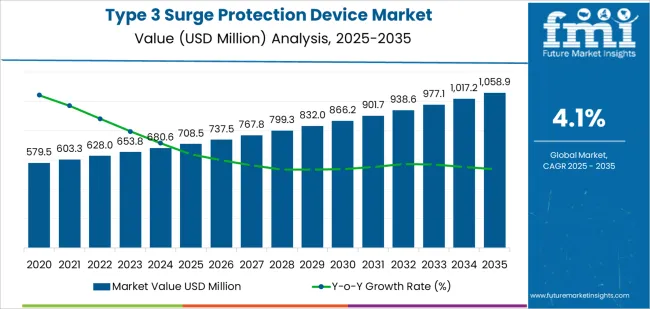
| Period | Primary Revenue Buckets | Share | Notes |
|---|---|---|---|
| Today | New device sales (plug-in, DIN-rail, embedded) | 44% | Installation-led, equipment protection-driven purchases |
| Replacement & upgrade installations | 26% | Aging device replacement, standard updates | |
| OEM equipment bundling | 18% | Integrated protection, factory installations | |
| Technical services & installation support | 12% | Application engineering, commissioning services | |
| Future (3-5 yrs) | Smart SPD systems | 38-42% | IoT connectivity, remote monitoring integration |
| Integrated protection solutions | 22-26% | Multi-level coordination, system-wide protection | |
| OEM partnership packages | 15-18% | Equipment integration, bundled solutions | |
| Replacement & aftermarket | 12-16% | Scheduled maintenance, emergency replacement | |
| Monitoring & analytics services | 8-12% | Cloud connectivity, predictive maintenance platforms | |
| Installation & commissioning (testing, certification, compliance) | 5-8% | Professional installation services |
| Metric | Value |
|---|---|
| Market Value (2025) | USD 708.5 million |
| Market Forecast (2035) | USD 1,058.9 million |
| Growth Rate | 4.1% CAGR |
| Leading Technology | Plug-in Installation Type |
| Primary Application | Power System Segment |
The market demonstrates strong fundamentals with plug-in installation systems capturing a dominant share through advanced surge protection capabilities and electrical equipment optimization. Power system applications drive primary demand, supported by increasing electronic equipment deployment and electrical safety requirements. Geographic expansion remains concentrated in developed markets with established electrical infrastructure, while emerging economies show accelerating adoption rates driven by power quality initiatives and rising equipment protection standards.
Primary Classification: The market segments by installation type into plug-in, DIN-rail mounted, and embedded categories, representing the evolution from basic protection equipment to sophisticated surge mitigation solutions for comprehensive electrical safety optimization.
Secondary Classification: Application segmentation divides the market into power systems, electronic equipment, communication systems, and household appliances, reflecting distinct requirements for surge protection, equipment safety, and installation compatibility standards.
Regional Classification: Geographic distribution covers North America, Latin America, Western Europe, Eastern Europe, East Asia, South Asia Pacific, and Middle East & Africa, with developed markets leading adoption while emerging economies show accelerating growth patterns driven by electrical infrastructure modernization programs.
The segmentation structure reveals technology progression from standard protection equipment toward sophisticated surge protection systems with enhanced response time and coordination capabilities, while application diversity spans from power distribution facilities to electronic equipment installations requiring precise surge mitigation solutions.
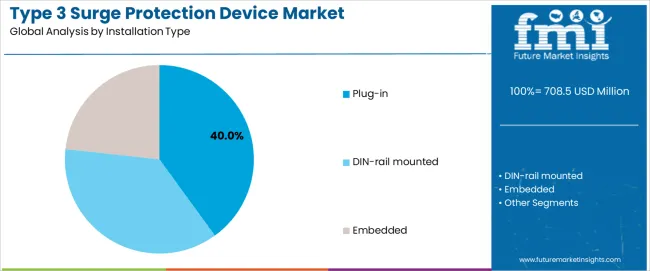
Market Position: Plug-in installation systems command the leading position in the Type 3 surge protection device market with 40% market share through advanced protection features, including superior surge clamping, installation flexibility, and electrical equipment optimization that enable residential and commercial facilities to achieve optimal equipment safety across diverse power distribution and electronic equipment environments.
Value Drivers: The segment benefits from residential and commercial preference for flexible protection systems that provide reliable surge mitigation, easy installation procedures, and equipment safety optimization without requiring significant infrastructure modifications. Advanced design features enable visual status indication, thermal protection, and integration with existing electrical outlets, where operational performance and user accessibility represent critical installation requirements.
Competitive Advantages: Plug-in systems differentiate through proven installation simplicity, consistent protection characteristics, and integration with standard electrical systems that enhance facility safety while maintaining optimal protection standards suitable for diverse residential and commercial applications.
Key market characteristics:
DIN-rail mounted systems maintain a 23.2% market position in the Type 3 surge protection device market due to their balanced installation properties and industrial application advantages. These systems appeal to facilities requiring distribution panel integration with competitive pricing for mid-scale industrial applications. Market growth is driven by commercial expansion, emphasizing reliable protection solutions and operational efficiency through optimized system designs.
Embedded systems capture market share through specialized protection requirements in OEM equipment, integrated installations, and dedicated application configurations. These facilities demand compact protection systems capable of handling specific requirements while providing effective surge mitigation capabilities and operational reliability.

Market Context: Power System applications demonstrate the highest growth rate in the Type 3 surge protection device market with 5.5% CAGR due to widespread adoption of electrical distribution systems and increasing focus on power quality optimization, equipment protection improvement, and facility safety applications that maximize equipment reliability while maintaining electrical standards.
Appeal Factors: Power system facility operators prioritize device reliability, protection coordination, and integration with existing electrical infrastructure that enables comprehensive surge protection across multiple distribution points. The segment benefits from substantial electrical investment and modernization programs that emphasize the acquisition of coordinated protection systems for safety optimization and equipment protection applications.
Growth Drivers: Electrical infrastructure expansion programs incorporate Type 3 SPDs as essential components for protection operations, while equipment modernization increases demand for reliable surge protection capabilities that comply with safety standards and minimize equipment damage risk.
Market Challenges: Varying voltage requirements and coordination complexity may limit device standardization across different facilities or application scenarios.
Application dynamics include:
Electronic Equipment applications capture market share through critical protection requirements in data centers, industrial control systems, and sensitive equipment installations. These facilities demand precise protection systems capable of operating with sensitive loads while providing effective surge mitigation and equipment safety capabilities.
Communication System applications account for market share, including telecommunications facilities, network equipment, and signal processing installations requiring specialized surge protection capabilities for equipment reliability and signal integrity optimization.
Market Position: East Asia commands significant market position with 5.5% CAGR through rapid infrastructure development that drives demand for surge protection solutions across residential and commercial electrical facilities.
Value Drivers: This region provides the ideal combination of construction activity and electrical modernization, meeting requirements for power distribution applications, equipment protection installations, and building safety projects without excessive technology complexity.
Growth Characteristics: The segment benefits from broad construction activity across building sectors, government electrical safety programs, and established electronics manufacturing that supports widespread adoption and operational efficiency.
| Category | Factor | Impact | Why It Matters |
|---|---|---|---|
| Driver | Electronic equipment proliferation & digitalization (IoT, smart devices) | ★★★★★ | Increasing sensitive equipment deployment requires effective surge protection with reliable performance and comprehensive equipment safety. |
| Driver | Electrical code requirements & safety standards (NEC, IEC compliance) | ★★★★★ | Building codes mandate surge protection installation; regulatory compliance drives device adoption in residential and commercial construction. |
| Driver | Power quality concerns & grid instability (voltage fluctuations) | ★★★★☆ | Unreliable power supply increases surge incidents; demand for protective devices expanding across residential and industrial sectors. |
| Restraint | Lack of awareness & installation understanding (especially residential) | ★★★★☆ | Limited end-user knowledge about surge protection benefits; slows adoption in cost-sensitive residential segments. |
| Restraint | Counterfeit products & quality inconsistency (market credibility) | ★★★☆☆ | Low-quality devices damage market reputation; price competition from substandard products affects premium segment positioning. |
| Trend | Smart SPD technology & remote monitoring | ★★★★★ | IoT connectivity enables status tracking and predictive maintenance; digital integration transforms devices from passive to active protection systems. |
| Trend | Coordinated protection & multi-level systems | ★★★★☆ | Integrated protection schemes across SPD types; system approach drives demand for engineered solutions and technical consultation. |
The Type 3 surge protection device market demonstrates varied regional dynamics with Growth Leaders including China (5.5% growth rate) and India (5.1% growth rate) driving expansion through electrical infrastructure initiatives and construction development. Steady Performers encompass Germany (4.7% growth rate), Brazil (4.3% growth rate), and developed regions, benefiting from established electrical markets and safety standard adoption. Emerging Markets feature developing regions, where power quality initiatives and building modernization support consistent growth patterns.
Regional synthesis reveals East Asian markets leading adoption through construction expansion and electrical infrastructure development, while South Asian countries maintain strong growth supported by urbanization and electrical safety advancement. European and North American markets show moderate growth driven by code compliance and equipment protection upgrade trends.
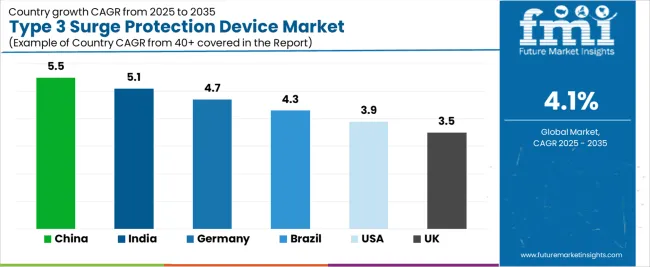
| Region/Country | 2025-2035 Growth | How to win | What to watch out |
|---|---|---|---|
| China | 5.5% | Lead with cost-effective solutions | Local competition; certification complexity |
| India | 5.1% | Focus on residential segment | Awareness gaps; distribution challenges |
| Germany | 4.7% | Offer premium quality systems | Strict standards; over-specification risks |
| Brazil | 4.3% | Value-oriented product mix | Economic volatility; grid reliability issues |
| United States | 3.9% | Provide code compliance support | Installer education; fragmented regulations |
| United Kingdom | 3.5% | Push smart monitoring features | Market maturity; Brexit certification impacts |
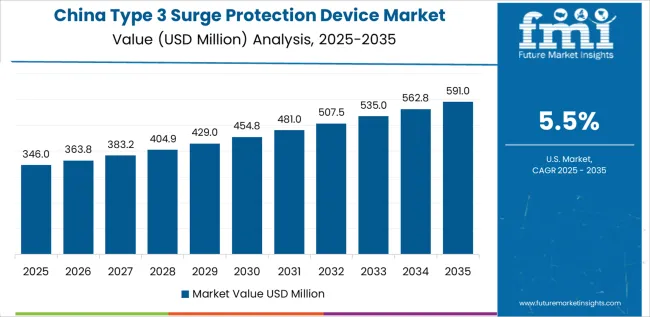
China establishes fastest market growth through aggressive electrical infrastructure programs and comprehensive construction development, integrating Type 3 surge protection devices as essential components in building installations and equipment protection applications. The country's 5.5% growth rate reflects government initiatives promoting electrical safety and domestic manufacturing capabilities that mandate the use of surge protection systems in residential and commercial electrical facilities. Growth concentrates in major urban centers, including Beijing, Shanghai, and Guangzhou, where electrical technology development showcases integrated protection systems that appeal to electrical contractors seeking advanced equipment safety capabilities and code compliance applications.
Chinese manufacturers are developing cost-effective protection solutions that combine domestic production advantages with performance features, including fast response time and reliable surge clamping capabilities. Distribution channels through electrical equipment suppliers and construction distributors expand market access, while government support for electrical safety standards supports adoption across diverse residential and commercial segments.
Strategic Market Indicators:
In Mumbai, Delhi, and Bangalore, residential buildings and commercial facilities are implementing Type 3 surge protection devices as essential equipment for electrical safety and equipment protection applications, driven by increasing government infrastructure investment and electrical modernization programs that emphasize the importance of surge mitigation capabilities. The market holds a 5.1% growth rate, supported by government electrical safety initiatives and construction development programs that promote surge protection systems for residential and commercial electrical facilities. Indian operators are adopting protection systems that provide reliable operational performance and cost-effective features, particularly appealing in regions where equipment safety and electrical quality represent critical installation requirements.
Market expansion benefits from growing construction activity capabilities and electrical equipment supply agreements that enable domestic availability of surge protection systems for residential and commercial applications. Technology adoption follows patterns established in electrical safety equipment, where reliability and value drive procurement decisions and installation deployment.
Market Intelligence Brief:
Germany establishes technology leadership through comprehensive electrical safety programs and advanced building infrastructure development, integrating Type 3 surge protection devices across residential and commercial electrical applications. The country's 4.7% growth rate reflects established electrical industry relationships and mature protection technology adoption that supports widespread use of premium surge protection systems in building and industrial facilities. Growth concentrates in major urban centers, including Frankfurt, Munich, and Hamburg, where electrical technology showcases mature protection deployment that appeals to electrical contractors seeking proven safety capabilities and code compliance applications.
German equipment providers leverage established distribution networks and comprehensive technical capabilities, including installation support and certification assistance that create customer relationships and operational advantages. The market benefits from mature electrical safety standards and building requirements that support surge protection system use while encouraging technology advancement and performance optimization.
Market Intelligence Brief:
Brazil's market expansion benefits from diverse construction demand, including residential development in São Paulo and Rio de Janeiro, commercial facility construction, and government electrical safety programs that increasingly incorporate protection solutions for equipment safety applications. The country maintains a 4.3% growth rate, driven by rising construction activity and increasing recognition of surge protection benefits, including equipment longevity and electrical system reliability.
Market dynamics focus on cost-effective protection solutions that balance operational performance with affordability considerations important to Brazilian electrical contractors. Growing urbanization creates continued demand for modern protection systems in new building infrastructure and electrical system modernization projects.
Strategic Market Considerations:
United States establishes market position through comprehensive electrical code programs and mature building infrastructure development, integrating Type 3 surge protection devices across residential and commercial electrical applications. The country's 3.9% growth rate reflects established electrical industry relationships and mature technology adoption that supports widespread use of protection systems in building and renovation facilities. Growth concentrates in major metropolitan regions, including California, Texas, and Florida, where building code requirements maintain steady surge protection device demand that appeals to contractors seeking proven safety capabilities and compliance applications.
American equipment distributors leverage established service networks and comprehensive product availability, including technical support and code compliance assistance that create customer advantages. The market benefits from mature electrical code requirements and safety standards that support protection system demand while encouraging performance improvements.
Market Intelligence Brief:
United Kingdom's market demonstrates mature protection deployment with operational effectiveness in residential applications and commercial facilities through integration with existing electrical systems and building infrastructure. The country maintains a 3.5% growth rate through replacement demand and code compliance upgrade programs. Urban regions, including London, Manchester, and Birmingham, showcase established installations where protection systems integrate with electrical panels and building safety programs to optimize equipment protection.
British distributors prioritize product availability and technical support in surge protection device supply operations, creating demand for reliable systems with proven performance, including installation guidance and certification support. The market benefits from established building regulations and a focus on electrical safety that provides steady installation demand and compliance with protection standards.
Market Intelligence Brief:
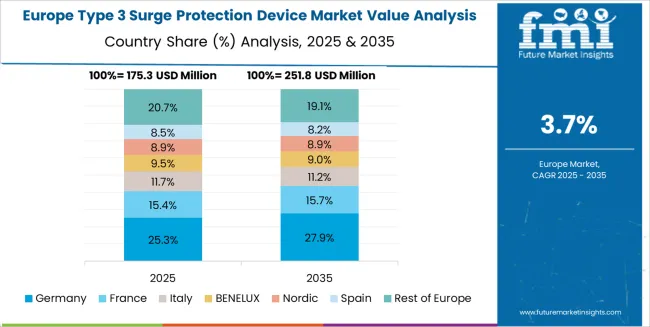
The Type 3 surge protection device market in Europe is projected to grow from USD 266.1 million in 2025 to USD 397.8 million by 2035, registering a CAGR of 4.1% over the forecast period. Germany is expected to maintain its leadership position with a 31.8% market share in 2025, supported by its advanced electrical infrastructure and major urban centers including Frankfurt and Munich.
United Kingdom follows with a 22.6% share in 2025, driven by comprehensive building regulation programs and electrical safety initiatives. France holds a 18.3% share through specialized residential applications and construction modernization requirements. Italy commands a 14.1% share, while Spain accounts for 9.4% in 2025. The rest of Europe region is anticipated to gain momentum, expanding its collective share from 3.8% to 4.6% by 2035, attributed to increasing surge protection device adoption in Nordic countries and emerging Eastern European construction projects implementing electrical safety programs.
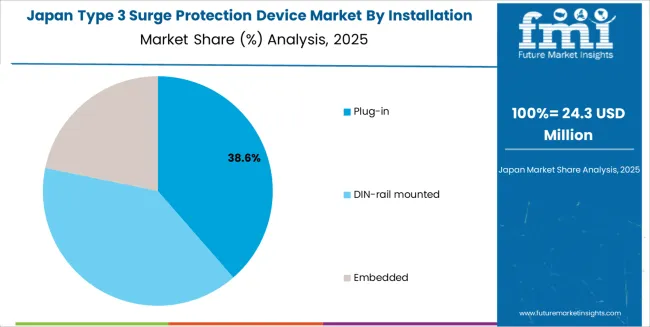
Japan's market exhibits sophisticated protection integration with documented operational effectiveness in residential buildings and commercial applications through compatibility with existing electrical systems and building infrastructure. The country maintains a 3.1% growth rate, leveraging engineering expertise in electrical safety and quality control. Urban centers showcase premium installations where protection systems integrate with comprehensive building management platforms and electrical monitoring systems to optimize equipment safety and power quality.
Japanese manufacturers prioritize system quality and electrical code compliance in surge protection device development, creating demand for premium products with advanced features, including fast response time and reliable status indication. The market benefits from established electrical infrastructure and investment in building safety that provides long-term operational benefits and compliance with electrical standards.

South Korea maintains a 2.9% growth rate through advanced building programs and electrical technology development initiatives that integrate surge protection systems across residential complexes, commercial buildings, and industrial applications. The country's electrical facilities implement protection solutions for equipment safety operations and power quality management, with technology adoption driven by construction modernization and smart building integration programs. Market development focuses on high-performance protection systems with enhanced monitoring capabilities and electrical coordination features for building applications.
The Type 3 surge protection device market operates with a moderately consolidated structure where 20-28 established players maintain significant presence, with the top 6-8 manufacturers holding approximately 48-54% market share by revenue. Market leadership is maintained through certification portfolio breadth, distribution network strength, technical support capabilities, and product quality consistency that enables reliable protection while maintaining competitive pricing across application segments.
Basic surge clamping functionality is becoming increasingly standardized, with entry-level Type 3 SPDs offering similar protection characteristics across manufacturers. However, margin opportunities exist in value-added features including smart monitoring capabilities, remote status indication, coordinated protection engineering, and comprehensive installation support services that extend beyond standard product supply.
Global electrical manufacturers compete through comprehensive protection portfolios and established contractor relationships, while specialized SPD manufacturers leverage technical expertise and application engineering capabilities. The competitive environment increasingly emphasizes certification compliance, installation simplicity, and total protection system coordination rather than purely device-based differentiation. Distribution channel strength through electrical wholesalers and contractor networks represents a critical competitive advantage, with established relationships creating barriers to entry for new participants without channel access.
Technology innovation focuses on IoT connectivity integration, enhanced surge clamping materials, thermal disconnect reliability, and coordination with upstream protection devices. However, fundamental Type 3 SPD architecture remains relatively stable, with competitive differentiation emerging through manufacturing quality consistency, certification breadth, and technical support capabilities. The market experiences moderate pricing pressure from Asian manufacturers, particularly in residential segments, while industrial and commercial categories maintain value through proven reliability and comprehensive technical documentation.
| Stakeholder | What they actually control | Typical strengths | Typical blind spots |
|---|---|---|---|
| Global electrical manufacturers | Product development, certification portfolio, distribution scale | Wide product range, brand trust, technical resources | Local installation practices; rapid customization |
| SPD specialists | Protection expertise, application engineering, testing capabilities | Technical depth, coordination studies, performance validation | Distribution breadth; brand recognition limitations |
| Electrical distributors | Channel access, contractor relationships, inventory management | Market coverage, logistics capability, credit facilities | Technical specification depth; product differentiation |
| OEM integrators | Equipment bundling, factory installation, specification influence | Complete solutions, warranty integration, volume leverage | Aftermarket presence; replacement market access |
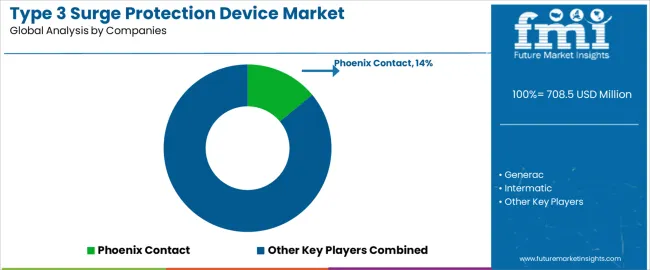
| Item | Value |
|---|---|
| Quantitative Units | USD 708.5 million |
| Installation Type | Plug-in, DIN-rail mounted, Embedded |
| Application | Power System, Electronic Equipment, Communication System, Household Appliances |
| Regions Covered | North America, Latin America, Western Europe, Eastern Europe, East Asia, South Asia Pacific, Middle East & Africa |
| Countries Covered | United States, China, Germany, India, United Kingdom, Japan, Brazil, and 20+ additional countries |
| Key Companies Profiled | Phoenix Contact, Generac, Intermatic, Leviton, Mersen, Siemens, Onccy, PD Devices, Shanghai Chenzhu Instrument, LSP, SUNTREE, Anhui Jinli Electric Tech, Yuelong Electric, Schneider Electric, Eaton, Littelfuse, ABB, CITEL, FATECH ELECTRONIC (FOSHAN) |
| Additional Attributes | Dollar sales by installation type and application categories, regional adoption trends across East Asia, South Asia Pacific, and Western Europe, competitive landscape with electrical equipment manufacturers and distribution suppliers, electrical contractor preferences for protection device reliability and system compatibility, integration with electrical systems and building management platforms, innovations in surge protection technology and performance enhancement, and development of advanced protection solutions with enhanced monitoring and electrical safety optimization capabilities. |
The global type 3 surge protection device market is estimated to be valued at USD 708.5 million in 2025.
The market size for the type 3 surge protection device market is projected to reach USD 1,058.9 million by 2035.
The type 3 surge protection device market is expected to grow at a 4.1% CAGR between 2025 and 2035.
The key product types in type 3 surge protection device market are plug-in, din-rail mounted and embedded.
In terms of application, power system segment to command 35.0% share in the type 3 surge protection device market in 2025.






Full Research Suite comprises of:
Market outlook & trends analysis
Interviews & case studies
Strategic recommendations
Vendor profiles & capabilities analysis
5-year forecasts
8 regions and 60+ country-level data splits
Market segment data splits
12 months of continuous data updates
DELIVERED AS:
PDF EXCEL ONLINE
Type-C Bulk Bags Market Size and Share Forecast Outlook 2025 to 2035
Competitive Overview of Type-C Bulk Bags Companies
Type 1 Surge Protection Device Market Size and Share Forecast Outlook 2025 to 2035
Type 2 Surge Protection Device Market Size and Share Forecast Outlook 2025 to 2035
Type 1 Commercial Surge Protection Devices Market Size and Share Forecast Outlook 2025 to 2035
V-type Classifiers Market Size and Share Forecast Outlook 2025 to 2035
V Type Fin Condenser Market Size and Share Forecast Outlook 2025 to 2035
V Type Air Cooled Condenser Market Size and Share Forecast Outlook 2025 to 2035
Dry-type Air-core Smoothing Reactor Market Size and Share Forecast Outlook 2025 to 2035
USB Type C Market Size and Share Forecast Outlook 2025 to 2035
Gel-Type Strong Acid Cation Exchange Resin Market Size and Share Forecast Outlook 2025 to 2035
Dry Type Distribution Transformer Market Size and Share Forecast Outlook 2025 to 2035
Dry Type Current Transformer Market Size and Share Forecast Outlook 2025 to 2035
Dry Type Automated Solar Panel Cleaning Market Size and Share Forecast Outlook 2025 to 2035
Dry Type Transformer Market Size and Share Forecast Outlook 2025 to 2035
Market Share Insights of the USB Type-C Industry
Stud Type Track Roller Market Size and Share Forecast Outlook 2025 to 2035
Foam Type Vacuum Gripping System Market Size and Share Forecast Outlook 2025 to 2035
Roll Type Thermal Paper Market Forecast and Outlook 2025 to 2035
Brush-Type Belt Cleaners Market Size and Share Forecast Outlook 2025 to 2035

Thank you!
You will receive an email from our Business Development Manager. Please be sure to check your SPAM/JUNK folder too.
Chat With
MaRIA